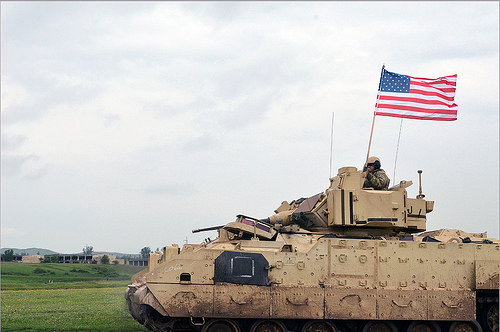 Less than three years after the United States Army sent home the last of its tanks that were permanently based in Europe, American commanders have been forced to rely on weapons shipped back temporarily or hardware borrowed from allies in the expanding effort to deter the latest threats from Russia with a fraction of the forces it had once deployed across the Continent….
Less than three years after the United States Army sent home the last of its tanks that were permanently based in Europe, American commanders have been forced to rely on weapons shipped back temporarily or hardware borrowed from allies in the expanding effort to deter the latest threats from Russia with a fraction of the forces it had once deployed across the Continent….
Mustering the necessary troops and equipment for the mission here can be a challenge, said Lt. Gen. Ben Hodges, the Army’s commanding general in Europe. The number of permanently stationed soldiers on the Continent has dropped by 35 percent since 2012, and the Army has reduced some of its vehicles, weapons and support equipment or relocated it to other bases.
The Black Hawk helicopters used in a NATO exercise at the training center here in August, for instance, were rotated in for nine months from Fort Stewart, Ga., General Hodges said. Bringing over more helicopters requires either the multiple weeks to bring them by ship or the extra money to bring them by cargo plane.
So he has to go borrowing.
“I don’t have bridges, I don’t have the trucks that can carry tanks, we don’t have enough helicopters to do what we need to do,” General Hodges said. “Practicing with British helicopters here is an essential part of it. Using British and German bridges, using Hungarian air defense is part of it….”
Even so, the Defense Department faces the challenge of managing a growing mission with a shrinking force, as the Army in Europe must train allies and deter any enemies with a tenth of the soldiers it once had….
As the Obama administration reduced the number of troops in Iraq and Afghanistan, the cuts in Europe deepened, with the number of permanently stationed soldiers dropping to about 26,000 from about 40,000 in 2012 this year; more cuts are anticipated under plans to shrink the Army to its smallest size since before World War II.
Officials cautioned that continued budget cuts could put the Army in a risky position should the armed forces be called upon again to conduct two large operations at once….
Lt. Gen. John Nicholson, commander of NATO’s Allied Land Command, said being able to quickly move soldiers and equipment helps deter aggressive actions in the first place.”If we get there late, then we may have to fight,” he said.
Image: Crew of a US Bradley vehicle participating in Noble Partner exercise, May 12, 2015 (photo: Sgt. A.M. LaVey/US Army)
